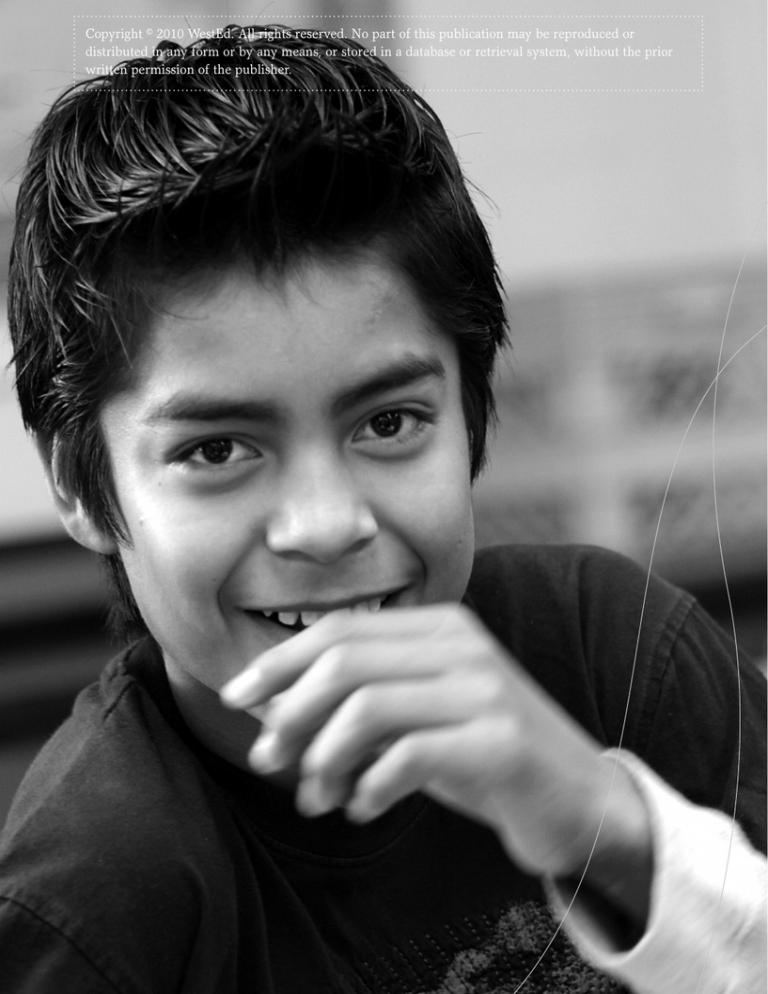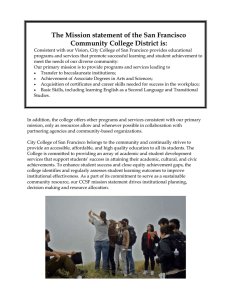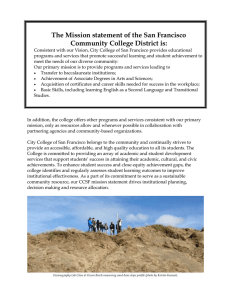
Copyright © 2010 WestEd. All rights reserved. No part of this publication may be reproduced or
distributed in any form or by any means, or stored in a database or retrieval system, without the prior
written permission of the publisher.
Copyright © 2010 WestEd. All rights reserved. No part of this publication may be reproduced or
distributed in any form or by any means, or stored in a database or retrieval system, without the prior
written permission of the publisher.
REFERENCES
Agar, M. (1994). Language shock: Understanding the culture of
conversation. New York: William Morrow.
Antón, M., & DiCamilla, F. (1988). Socio-cognitive functions of L1
collaborative interaction in the L2 classroom. The Canadian
Modern Language Review, 54(3), 314–342.
Bakhurst, D. (1991). Consciousness and revolution in Soviet
psychology. Cambridge, UK: Cambridge University Press.
Batalova, J., Fix, M., & Murray, J. (2007, March). Measures of
change: The demography and literacy of adolescent English
learners: A report to Carnegie Corporation of New York.
Washington, DC: Migration Policy Institute.
Bransford, J., Brown, A., & Cocking, R. (Eds.). (2000). How people
learn: Brain, mind, experience, and school. Washington, DC:
National Academy Press.
Bransford, J., & Johnson, M. (1972). Contextual prerequisites
for understanding: Some investigations of comprehension
and recall. Journal of Verbal Learning and Verbal Behavior, 11,
717–726.
Bransford, J., & Johnson, M. (1973). Considerations of some
problems of comprehension. In W. Chase (Ed.), Visual
information processing (pp. 383–438). New York: Academic
Press.
Bronfenbrenner, U. (1979). The ecology of human development:
Experiments by nature and design. Cambridge, MA: Harvard
University Press.
Scaffolding the Academic Success of Adolescent English Language Learners
189
Copyright © 2010 WestEd. All rights reserved. No part of this publication may be reproduced or
distributed in any form or by any means, or stored in a database or retrieval system, without the prior
written permission of the publisher.
Brooks, F., Donato, R., & McGlone, J. (1997). When are they going to say
‘it’ right? Understanding learner talk during pair-work activity. Foreign
Language Annals, 30(4), 524–541.
Bruner, J., & Sherwood, V. (1976). Peekaboo and the learning of rule
structures. In J. Bruner, A. Jolly, & K. Sylva (Eds.), Play: Its role in
development and evolution (pp. 277–287). Harmondsworth, UK:
Penguin Books.
Cazden, C. (1981). Performance before competence: Assistance to child
discourse in the zone of proximal development. Quarterly Newsletter of
the Laboratory of Comparative Human Cognition, 3, 5–8.
Clay, M., & Cazden, C. (1992). A Vygotskian interpretation of Reading
Recovery. In C. Cazden (Ed.), Whole language plus: Essays on literacy in
the United States and New Zealand (pp. 114–135). New York: Teachers
College Press.
Chomsky, N. (1986). Knowledge of language. Cambridge, MA: MIT Press.
Cohen, A., & Walqui, A. (2007). Three moments in teaching a Robert Frost
poem [DVD]. San Francisco: WestEd.
Cohen, D. (1988). Teaching practice: Plus ça change …. In P. Jackson (Ed.),
Contributing to educational change: Perspectives on research and practice
(pp. 27–84). Richmond, CA: McCutchan Publishing.
Cole, M. (1985). The zone of proximal development: Where culture and
cognition create each other. In J. Wertsch (Ed.), Culture, communication,
and cognition. New York: Cambridge University Press.
Cook, V. (1995). Multi-competence and the learning of many languages.
Language, culture, and curriculum, 8(2), 93–98.
Crescenzi, S., & Walqui, A. (2008). Brain injury jigsaw project [DVD]. San
Francisco: WestEd.
Csikszentmihalyi, M. (1990). Flow: The psychology of optimal experience.
New York: Harper and Row.
190
Scaffolding the Academic Success of Adolescent English Language Learners
Copyright © 2010 WestEd. All rights reserved. No part of this publication may be reproduced or
distributed in any form or by any means, or stored in a database or retrieval system, without the prior
written permission of the publisher.
Csikszentmihalyi, M., & Schmidt, J. (1998). Stress and resilience in
adolescence: An evolutionary perspective. In K. Borman & B.
Schneider (Eds.), The adolescent years: Social influences and educational
challenges. Ninety-seventh Yearbook of the National Society for the Study of
Education. Chicago: The University of Chicago Press.
Cummins, J. (1984). Bilingualism and special education: Issues in assessment
and pedagogy. San Diego, CA: College-Hill Press.
Cummins, J. (1996). Negotiating identities: Education for empowerment in
a diverse society. Los Angeles: California Association for Bilingual
Education.
Deci, E., & Flaste, R. (1995). Why we do what we do: Understanding selfmotivation. New York: Penguin Group (USA).
DeFazio, A., & Walqui, A. (2001). Where do you want to go next? [DVD].
San Francisco: WestEd.
Donato, R. (1994). Collective scaffolding. In J. Lantolf & G. Appel (Eds.),
Vygotskian approaches to second language research (pp. 33–56). Norwood,
NJ: Ablex Publishers.
Ellis, R. (2005). Instructed second language acquisition. A literature review.
Wellington, NZ: New Zealand Ministry of Education.
Ellis, R. (2006). Current issues in the teaching of grammar: An SLA
perspective. TESOL Quarterly, 40(1), 83–107.
Ellis, R. (2008). Principles of instructed second language acquisition. CAL
Digest, Washington, DC: Center for Applied Linguistics.
Elmore, R. F. (1996). Getting to scale with good educational practices.
Harvard Educational Review, 66, 1–25.
Fleming, S. (1994). It takes two to tango. Unpublished MA project, Monterey
Institute of International Studies, Monterey, CA.
References
191
Copyright © 2010 WestEd. All rights reserved. No part of this publication may be reproduced or
distributed in any form or by any means, or stored in a database or retrieval system, without the prior
written permission of the publisher.
Frost, R. (1916). The road not taken. Retrieved April 15, 2009, from
http://en.wikipedia.org/wiki/The_Road_Not_Taken_(poem)
Gándara, P., & Contreras, F. (2009). The Latino education crisis. The
consequences of failed social policies. Cambridge, MA: Harvard
University Press.
Gándara, P., Maxwell-Jolly, J., & Driscoll, A. (2005). Listening to teachers
of English language learners: A survey of California teachers’ challenges,
experiences, and professional development needs. Santa Cruz, CA: The
Center for the Future of Teaching and Learning.
García, V., Agbemakplido, W., Abdella, H., Lopez, O., & Registe, R. (2006).
High school students’ perspectives on the 2001 No Child Left Behind
Act’s definition of a highly qualified teacher. Harvard Educational
Review, 76(4), 698–724.
Gibbons, P. (2002). Scaffolding language, scaffolding learning. Portsmouth,
NH: Heinemann.
Gibbons, P. (2003). Mediating language learning: Teacher interactions with
ESL students in a content based classroom. TESOL Quarterly, 37(2),
247–273.
Gibbons, P. (2005). Putting scaffolding to work: The contribution of
scaffolding in articulating ESL education. Prospect, 20(1), 6–30.
Gibbons, P. (2009). English learners, academic literacy, and thinking: Learning
in the challenge zone. Portsmouth, NH: Heinemann.
Gibbs, R. (2005). Embodiment and cognitive science. New York: Cambridge
University Press.
Gonzales, A., & Walqui, A. (2004). Appropriating the academic language of
geometry [DVD]. San Francisco: WestEd.
Graves, K. (1996). A framework of course development processes. In
K. Graves (Ed.), Teachers as course developers (pp. 12–38). Cambridge,
UK: Cambridge University Press.
192
Scaffolding the Academic Success of Adolescent English Language Learners
Copyright © 2010 WestEd. All rights reserved. No part of this publication may be reproduced or
distributed in any form or by any means, or stored in a database or retrieval system, without the prior
written permission of the publisher.
Hernandez, A. (n.d.). Second-language writers: The writing of secondlanguage children. In Professional development for teachers of English
language learners. San Diego, CA: San Diego County Office of
Education.
Hopstock, P., & Stephenson, T. (2003). Descriptive study of services to LEP
students and LEP students with disabilities. Special topic report #2: Analysis
of Office of Civil Rights (OCR) data related to LEP students. Washington,
DC: U.S. Department of Education, Office of English Language
Acquisition, Language Enhancement, and Academic Achievement for
Limited English Proficient Students (OELA).
Jastrow, J. (1899). The mind’s eye. Popular Science Monthly, 54, 299–312.
Retrieved April 2, 2009, from http://commons.wikimedia.org/wiki/
File:Duck-Rabbit_illusion.jpg
Kramsch, C. (1993). Context and culture in language teaching. Oxford, UK:
Oxford University Press.
Lantolf, J., & Thorne, S. (2006). Sociocultural theory and the genesis of second
language development. Oxford, UK: Oxford University Press.
Lave, J., & Wenger, E. (1991). Situated learning: Legitimate peripheral
participation. New York: Cambridge University Press.
Long, M. (1996). The role of linguistic environment in second language
acquisition. In W. Ritchie & T. Bhatia (Eds.), Handbook of second
language acquisition (pp. 413–468). San Diego, CA: Academic Press.
Mercer, N. (1995). The guided construction of knowledge: Talk between
teachers and learners in the classroom. Clevedon, UK: Multilingual
Matters.
Merton, R. (1968). Social theory and social structure (Rev. ed.). New York:
The Free Press.
Ng, R., & Walqui, A. (2005a). Teaching Black Boy in three moments [DVD].
San Francisco: WestEd.
References
193
Copyright © 2010 WestEd. All rights reserved. No part of this publication may be reproduced or
distributed in any form or by any means, or stored in a database or retrieval system, without the prior
written permission of the publisher.
Ng, R., & Walqui, A. (2005b). Oral development jigsaw project [DVD]. San
Francisco: WestEd.
Norton Peirce, B. (1995). Social identity, investment, and language learning.
TESOL Quarterly, 29(1), 9–31.
Passel, J. (2006, March 7). The size and characteristics of the unauthorized
migrant population in the U.S. PEW Hispanic Center. Retrieved October
10, 2009, from http://pewhispanic.org/reports/report.php?ReportID=61
Pinker, S. (1994). The language instinct. New York: William Morrow.
Price, J., & Walqui, A. (2001). Scaffolding the 14th Amendment [DVD]. San
Francisco: WestEd.
Quality Teaching for English Learners. (2006). Unit 3: Introduction to
Shakespeare: Macbeth. Module 10. Teaching language arts 11–12 to
English language learners. San Francisco: WestEd.
Resnick, L., Hall, M., & Fellows of the Institute for Learning. (2006).
Principles of learning: Study tools for education [CD-ROM]. Pittsburgh,
PA: University of Pittsburgh, Institute for Learning, Learning Research
and Development Center.
Rodríguez, Luis. (1993). Always running: La vida loca: Gang days in L.A.
New York: Touchstone.
Rogoff, B. (1995). Observing sociocultural activity on three planes:
Participatory appropriation, guided participation, and apprenticeship.
In J. Wertsch, P. del Rio, & A. Alvarez (Eds.), Sociocultural studies of the
mind (pp. 139–164). New York: Cambridge University Press.
Rosenthal, R., & Jacobson, L. (1966). Teachers’ expectancies: Determinates
of pupils’ IQ gains. Psychological Reports, 19, 115–118.
Ryan, K., & Walqui, A. (2008). Novel ideas only in preparing learners to read
“The Necklace” [DVD]. San Francisco: WestEd.
194
Scaffolding the Academic Success of Adolescent English Language Learners
Copyright © 2010 WestEd. All rights reserved. No part of this publication may be reproduced or
distributed in any form or by any means, or stored in a database or retrieval system, without the prior
written permission of the publisher.
Schleppegrell, M. (forthcoming). Language in academic subject areas and
classroom instruction: What is academic language and how can we teach it?
Shakespeare, W. (n.d.). Macbeth. Retrieved April 15, 2009, from
http://www.gutenberg.org/etext/2264
Shulman, L. (1987). Knowledge and teaching: Foundations of the new
reform. Harvard Educational Review, 57, 114–135.
Skutnabb-Kangas, T. (1984). Bilingualism or not: The education of minorities.
Clevedon, UK: Multilingual Matters.
Stenhouse, L. (1975). An introduction to curriculum research and development.
London: Heinneman.
Suárez-Orozco, C., Suárez-Orozco, M., & Todorova, I. (2008). Learning a
new land. Immigrant students in American society. Cambridge, MA:
The Belknap Press of Harvard University Press.
Swain, M., & Lapkin, S. (2000). Task-based second language learning:
The uses of the first language. Language Teaching Research, 4(3),
251–274.
Tharp, R., & Gallimore, R. (1988). Rousing minds to life: Teaching, learning,
and schooling in social context. New York: Cambridge University Press.
Turnbull, M., & Arnett, K. (2002). Teachers’ uses of the target and first
­languages in second and foreign language classrooms. Annual Review of
Applied Linguistics, 22, 204–218.
Valsiner, J. (2006, September). Beyond the first language: Acquisition without
learning. Invited presentation at the Thirteenth Annual Sociocultural
Theory and Second Language Learning Research Working Group,
University of Massachusetts, Amherst.
van Lier, L. (1996). Interaction in the language curriculum: Awareness,
­autonomy, and authenticity. London: Longman.
References
195
Copyright © 2010 WestEd. All rights reserved. No part of this publication may be reproduced or
distributed in any form or by any means, or stored in a database or retrieval system, without the prior
written permission of the publisher.
van Lier, L. (2004). The ecology and semiotics of language learning: A socio­
cultural perspective. Dordrecht, NL: Kluwer Academic.
Verhoeven, L. (1990). Acquisition of reading in a second language. Reading
Research Quarterly, 25, 90–114.
Voloshinov, V. (1973). Marxism and the philosophy of language. Cambridge,
MA: Harvard University Press.
Vygotsky, L. (1962). Thought and language. Cambridge, MA: MIT Press.
Vygotsky, L. (1976). Play and its role in the mental development of
the child. In J. Bruner, A. Jolly, & K. Sylva (Eds.), Play: Its role in
development and evolution (pp. 537–554). Harmondsworth, UK: Penguin
Books.
Vygotsky, L. (1978). Mind in society. Cambridge, MA: Harvard University
Press.
Walqui, A. (1992). Sheltered instruction: Doing it right. San Diego, CA.
San Diego County Office of Education.
Walqui, A. (2001). Accomplished teaching with English learners:
A conceptualization of teacher expertise. Multilingual Educator 1(4),
55–55.
Wood, D., Bruner, J., & Ross, G. (1976). The role of tutoring in problem
solving. Journal of Child Psychology and Psychiatry, 17, 89–100.
Wright, R. (1945/1998). Black Boy. New York: HarperCollins.
This is an excerpt only. Continue to sample the book or
return to the book description and shopping cart.
196
Scaffolding the Academic Success of Adolescent English Language Learners



